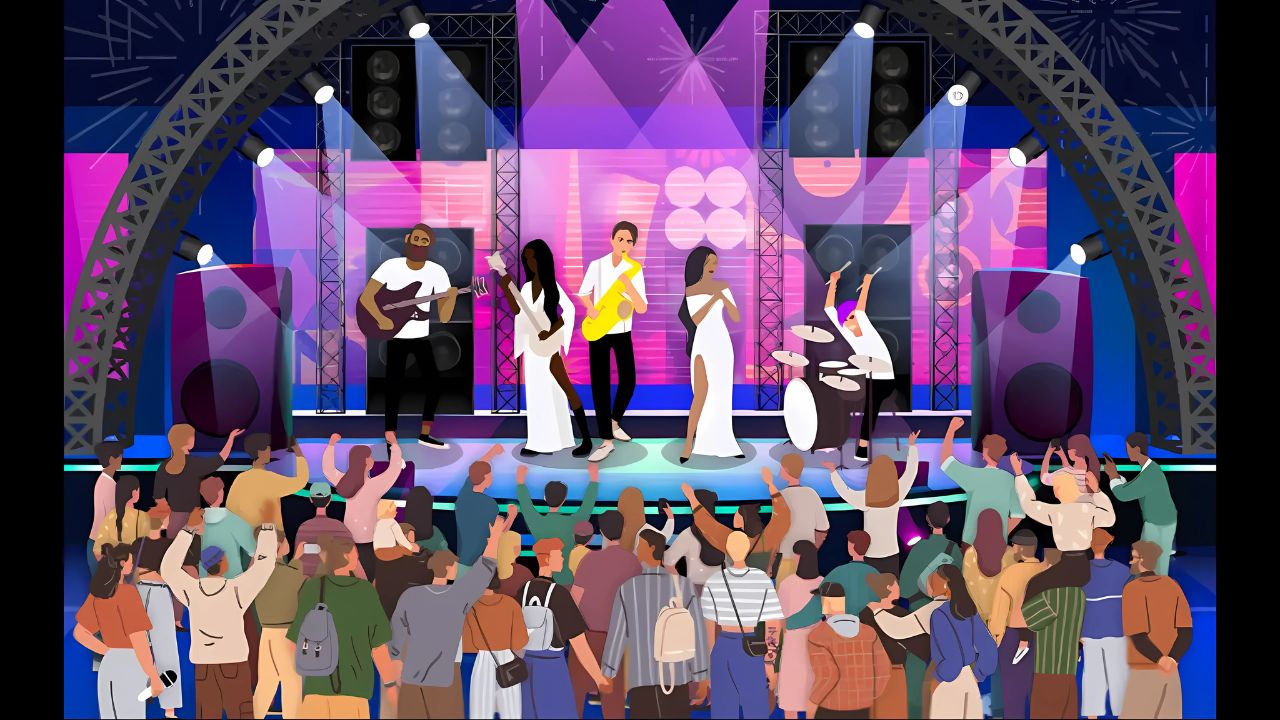The Fascinating World of Visual Perception Challenges
Human perception remains one of the most intriguing aspects of cognitive science. Our brains constantly process thousands of visual stimuli every single second, yet sometimes the most obvious things escape our notice completely.

This particular optical illusion has captured millions of viewers worldwide. The challenge seems deceptively simple at first glance, but proves surprisingly difficult for most people attempting it.
Visual puzzles like this one test our ability to distinguish relevant information from background noise. They reveal how our cognitive processing works under pressure and time constraints.
The eight-second timeframe adds an element of urgency that makes the challenge even more compelling. Most people find themselves frantically scanning the image, hoping to spot the elusive microphone before time runs out.
Why Eight Seconds Matter
Research shows that first impressions form within milliseconds of viewing an image. However, detailed analysis requires sustained attention and systematic searching techniques.
Eight seconds provide just enough time for a thorough examination while maintaining the pressure that makes the challenge exciting. This specific duration has proven optimal for engagement across social media platforms.
The time constraint forces your brain to work efficiently, filtering through visual information rapidly. Some people thrive under this pressure, while others find it overwhelming and counterproductive.
The Psychology Behind Hidden Object Games
Hidden object puzzles tap into our natural hunting instincts that evolved over thousands of years. Our ancestors needed sharp visual skills to spot food, predators, and other important elements in their environment.
Modern life rarely demands such intense visual scanning, making these puzzles both challenging and satisfying. They exercise mental muscles that don’t get much workout in our digital age.
The satisfaction of finding hidden objects triggers dopamine release in our brains. This neurochemical reward system explains why people become addicted to visual puzzle games and challenges.
Understanding the Crowd Scene Complexity
Visual Overload and Information Processing
The crowd image contains dozens of individual elements competing for your attention. Each person represents a potential distraction from your primary objective of finding the microphone.
Human faces naturally draw our focus because we’re evolutionarily programmed to recognize and analyze facial expressions. This biological tendency works against us in this particular challenge.
The artist who created this illusion understood these psychological principles perfectly. They deliberately positioned elements to exploit our natural biases and make the search more difficult.
Background patterns, clothing textures, and overlapping figures create additional visual complexity. Your brain must filter through all this information while maintaining focus on the search objective.
Color Theory and Camouflage Techniques
Professional artists use sophisticated color matching techniques to hide objects within complex scenes. The microphone’s coloring likely blends seamlessly with surrounding elements.
Shadows and lighting effects add another layer of camouflage that makes detection more challenging. What appears obvious in good lighting might become nearly invisible under different conditions.
Texture patterns in clothing and backgrounds can mask the microphone’s distinctive shape. Our brains sometimes interpret these patterns as continuous surfaces rather than separate objects.
The strategic use of contrast levels helps objects disappear into their surroundings. Too much contrast makes things obvious, while too little makes them completely invisible.
Developing Systematic Search Strategies
The Grid Method Approach
Dividing the image into a mental grid helps ensure comprehensive coverage during your search. Start with the top-left corner and work systematically across each row.
This methodical approach prevents the random scanning that often leads to repeatedly checking the same areas while missing others entirely.
Professional image analysts use similar techniques when examining crime scene photos or satellite imagery. The same principles apply to recreational visual puzzles.
Grid searching requires discipline and patience, qualities that improve with practice. Many people struggle with this systematic approach because it feels slow and methodical.
Edge-to-Center Scanning Technique
Starting your search along the image borders can be surprisingly effective. Many puzzle creators avoid placing hidden objects in the most obvious central locations.
The human eye tends to focus on the center of images first, making edge placement an effective hiding strategy. This natural bias works against us in hidden object challenges.
Corner areas often receive less scrutiny during casual viewing. Experienced puzzle solvers always check these regions thoroughly before moving to more obvious locations.
The edge-to-center approach also helps establish boundaries for your search area, preventing the overwhelmed feeling that comes from trying to process everything simultaneously.
Pattern Recognition Techniques
Training your brain to recognize geometric shapes within complex scenes improves your success rate significantly. Microphones have distinctive forms that stand out once you know what to look for.
Breaking down the search into shape categories rather than looking for specific objects can be more effective. Focus on finding cylindrical or rectangular forms within the crowd.
Symmetry detection is another powerful tool in visual searching. Most microphones have symmetrical designs that create recognizable patterns even when partially obscured.
Color gradient analysis helps identify objects that don’t belong in their surroundings. Microphones often have different surface textures that reflect light differently than clothing or skin.
The Neuroscience of Visual Processing
How Our Brains Handle Complex Scenes
The visual cortex processes different aspects of images simultaneously. Color, movement, shapes, and depth information all get analyzed through separate neural pathways.
This parallel processing usually helps us navigate complex environments efficiently. However, it can also lead to overlooking important details when we’re focused on specific search tasks.
Attention blindness occurs when we concentrate so intensely on finding something that we miss obvious elements right in front of us. This phenomenon explains why the microphone might be hiding in plain sight.
The brain’s predictive processing fills in gaps based on expectations rather than actual visual input. Sometimes we see what we expect rather than what’s there.
Individual Differences in Visual Processing
Some people have naturally superior pattern recognition abilities that make them excel at hidden object challenges. These differences often appear early in childhood and remain consistent throughout life.
Age factors significantly impact visual processing speed and accuracy. Younger individuals typically perform better on timed challenges, while older adults may excel at careful, methodical searching.
Cultural background influences how we interpret visual scenes. People from different cultures may focus on different aspects of the same image based on their learned visual priorities.
Practice effects demonstrate that regular engagement with visual puzzles genuinely improves performance over time. The brain develops more efficient search strategies through repeated exposure.
Common Mistakes and How to Avoid Them
The Tunnel Vision Trap
Many searchers develop tunnel vision when they think they’ve spotted the microphone. They focus intensely on one area while ignoring other possibilities.
This fixation tendency causes people to waste precious seconds examining irrelevant details. Learning to quickly assess and move on is crucial for success.
Confirmation bias makes us see microphones in random objects that share similar shapes or colors. Critical evaluation helps distinguish real targets from false positives.
The pressure of the time limit often exacerbates tunnel vision problems. Anxiety narrows our focus when we need broader awareness for effective searching.
Overthinking the Challenge
Some people assume the microphone must be cleverly disguised or transformed in some way. This assumption leads them to ignore obvious candidates that seem too simple.
Overcomplication causes searchers to develop elaborate theories about where the object might be hidden instead of conducting systematic searches.
The desire to be clever sometimes overrides basic visual scanning techniques. Simple, methodical approaches often outperform complex strategies in these challenges.
Second-guessing initial impressions can be counterproductive. If something looks like a microphone, it probably is, even if the placement seems obvious or straightforward.
Speed Versus Accuracy Balance
Rushing through the search often leads to missing obvious targets. The eight-second limit encourages speed, but accuracy should remain the primary focus.
Some people sacrifice thoroughness for speed, repeatedly scanning the same areas rather than examining each section carefully once.
Finding the right rhythm between speed and precision requires practice. Experienced puzzle solvers develop efficient scanning patterns that maximize both factors.
Panic responses to time pressure typically reduce performance rather than improving it. Staying calm and focused produces better results than frantic searching.
Training Your Visual Perception Skills

Daily Practice Routines
Spending just ten minutes daily on visual puzzles can dramatically improve your pattern recognition abilities. Consistency matters more than the duration of individual practice sessions.
Progressive difficulty helps build skills gradually without creating frustration. Start with easier challenges and gradually work up to more complex hidden object puzzles.
Varying the types of puzzles you practice prevents skill stagnation. Different challenges exercise different aspects of visual processing and keep training interesting.
Online platforms offer unlimited access to visual challenges of varying difficulty levels. Many sites track your progress and adapt difficulty based on your performance.
Cross-Training with Related Skills
Reading comprehension exercises improve your ability to extract relevant information from complex visual scenes. The skills transfer surprisingly well between text and image analysis.
Memory games enhance your capacity to hold multiple search targets in mind simultaneously. This skill proves valuable when looking for several hidden objects in a single image.
